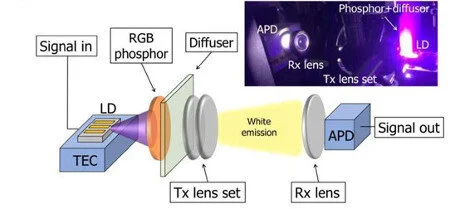Semiconductor Today features "Near-ultraviolet laser diodes powering visible light communication"
"Researchers based in the USA and Saudi Arabia claim the first demonstration of the use of near-ultraviolet (NUV) laser diodes (LDs) and red-green-blue (RGB) phosphors for white visible light communication (VLC). The team is at University of California Santa Barbara (UCSB), King Abdullah University of Science and Technology (KAUST) in Saudi Arabia, and University of Wisconsin-Madison in the USA."
"An advantage of using NUV would be reduced noise from solar radiation, compared with blue emitters. ... Potential uses of white-light VLC include light fidelity (LiFi) networks, underwater wireless optical communications (UWOC), and plastic optical fiber (POF) communications."
"The -3dB bandwidth for modulation was ~1GHz. The limited bandwidth was attributed to the avalanche photodetector (APD), since the LD was expected to have a bandwidth of the order 5GHz or more. ... The LD-phosphor system realized CRI (color rendering index) up to 79 with CCT (correlated color temperature) of 4050-4700K."
Read more in Semiconductor Today
Gigabit-per-second white light-based visible light communication using near-ultraviolet laser diode and red-, green-, and blue-emitting phosphors
Changmin Lee, Chao Shen, Clayton Cozzan, Robert M. Farrell, James S. Speck, Shuji Nakamura, Boon S. Ooi, and Steven P. DenBaars
Optics Express, 25(15), 17480-17487 (2017)
http://www.semiconductor-today.com/news_items/2017/aug/usb_090817.shtml

